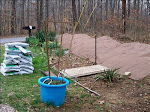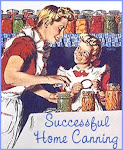How I Spent My Summer Vacation
This year, instead of a vacation, Hub and I decided to invest in food. Don’t laugh. According to an article in the Wall Street Journal, food prices are skyrocketing. (http://finance.yahoo.com/banking-budgeting/article/104914/Load-Up-the-Pantry). With news about Peak Oil/Hubbert’s Peak, climate changes, water shortages and food riots foremost in our minds, we decided to store food and water, plant a garden, compost, “go green.” Sharon’s Food Independence Days Challenge provided the incentive and encouragement we needed to get it in gear. Problem is, we live in a plastic neighborhood with tiny trees and a homeowner’s association. So how does one go green in this setting? How do we recreate our own Golden Acre?
Our first order was to line up additional medications. We increased the size of our first aid kit. Bought a half dozen large boxes of matches and gathered all the candle making supplies together. That was easy enough.
55-gallon water tanks are one of our first priorities. We plan to fill and seal two barrels and place them in the garage as an emergency water supply. Then the other barrels will be stationed at the downspouts from the gutters. With proper screening and a spigot we can provide water for our gardens almost all season. I say “almost” because with climate changes I’m not sure if we’ll catch the usual 10,000 gallons of water.
Learn how to properly store food. Peggy Layton has an excellent book titled Food Storage 101: Where Do I Begin? In the book she outlines a six month plan for stocking up. I’m still in the process of organizing the larder. More on that later.
Recycle. We used old Pepsi bottles (Hub is addicted) to store grains and beans. We use the plastic Tidy Cat containers to store charcoal, seeds, bird food and cat food. My son Jacob suggested we use any glass bottles to create a wind garden. You plant the bottle open end up and when the wind blows across the top, you hear music. We save jars for storage. Other than that, our recycling is all paper, mostly junk mail.
Compost. We have three stages of compost here. The rawest is in a garbage can beside the real garbage can. Scraps go into that, then a layer of dirt, then a layer of dung and so on until the can is full. Then the contents are dumped out on the ground in the back yard and covered with more compost. My son Zach put up a lattice fence and planted morning glories to hide the compost. After that pile has aged it will go into the courtyard corner in a pile. We also sport a 4 ft high pile of gourmet compost in the same yard.
This week for the food challenge I did these things:
Planted peas, limas, bush beans, tomatoes, basil, cukes, okra. We’ve started zucchini, pumpkin, and squash. We’ve kept the gardening loose in style so that from a distance the vegetables look like flower vines and shrubs. We’ve planted herbs in the veggie beds, and marigolds in all the beds as a natural pest repellant.
Harvest: I harvested a bushel of lime mint that I’m drying for tea.
Prep: Bought a pressure cooker and four dozen Ball jars with extra lids and bands for canning. Marked off wildflower patches for bees in preparation of getting a hive next year.
Store: Placed a large coop order for six different kinds of beans, sunflower seed, sprouting seed, a gallon of honey, flax, oats, popcorn and brown rice. These foods come in 6-gallon pails and have been sprayed with nitrogen to kill infestation. I store mine with a few organic bay leaves scattered throughout the bucket as a preventative. I use gamma lids on buckets that I frequently open and the rubber-seal lids for foods that I open every once in a while. From Walton Feed we ordered dehydrated peppers, corn, celery, carrots, mushrooms, as well as 50# baking soda, bouillon, blueberry muffin mix, granola, dry milk, biscuit mix, tomato powder, and potato flakes. We haven’t used dehydrated carrots or celery yet, but thought we’d try using them in soups. Instructions for rehydrating foods can be found in Peggy Layton’s Food Storage 101 book.
Learn Something New. My newest new thing is learning to blog. Bear with me.
Contribute to local food systems. We still shop the local farmer’s market and we’ll buy our produce for canning from local farmers. We spread compost around our neighbor’s tree and gave him some seed.
Practicing a more eco-friendly lifestyle in the 'burbs while pursuing arts in the city.
Rainbow Swiss Chard

Companion Planting Poster


Blessed Worms
Facebook Badge


Corn Silks

the female part of corn
Corn Tassles

the male part of corn

Start NOW to work the soil for Spring.

Survival Seeds.com
Seed from HometownSeeds.com included:
Black Beauty summer squash, Swiss chard, Yolo Wonder sweet pepper, Champion radish, Bantam corn, Scarlet Nantes carrot, Long Green cucumbers, Golden Acre cabbage, Kentucky Wonder Pole beans, Rutgers tomatoes, Waltham Butternut winter squash, Detroit Dark Red Beets, Lincoln Peas, Parris Island Romaine Lettuce, Bloomsdale Spinach
http://www.hometownseeds.com/survival-seeds-c-213/survival-seeds-peace-of-mind-for-your-family-p-35.
Black Beauty summer squash, Swiss chard, Yolo Wonder sweet pepper, Champion radish, Bantam corn, Scarlet Nantes carrot, Long Green cucumbers, Golden Acre cabbage, Kentucky Wonder Pole beans, Rutgers tomatoes, Waltham Butternut winter squash, Detroit Dark Red Beets, Lincoln Peas, Parris Island Romaine Lettuce, Bloomsdale Spinach
http://www.hometownseeds.com/survival-seeds-c-213/survival-seeds-peace-of-mind-for-your-family-p-35.
Get Busy!

Zone 7
With lower elevations and longer days, a variety of vegetables will thrive in a Zone 7 garden. Lettuce, cabbage, broccoli and Brussels sprouts can be planted before the last frost. Carrots, beets, radishes, and parsnips will also do well. Onions, potatoes, peas, radishes, salad greens, and a variety of herbs can also be planted during this time frame. Most areas in zone 7 get moderate to high rainfall and many areas have little snowcover in winter. This makes zone 7 gardening an ideal gardening environment. Fall-grown vegetables, in particular, are usually of very high quality.
Read more at Suite101: Zone 7 Gardening: Growing Vegetables in the "Middle Ground" Suite101.com http://vegetablegardens.suite101.com/article.cfm/zone_7_gardening#ixzz0aQUvPuRG
Read more at Suite101: Zone 7 Gardening: Growing Vegetables in the "Middle Ground" Suite101.com http://vegetablegardens.suite101.com/article.cfm/zone_7_gardening#ixzz0aQUvPuRG
Living & Eating Local ~ It can be done! ~
All Season's ~ Local Cheese,Beer and Wine making supplies
Back to the Land Store ~ Erin,TN
Bugtusslefarm ~ CSA
Davidson County Master Gardeners
Delvin Farms ~ CSA
East Nashville Organic/Local Farmer's Mkt
Eaton Creek Farm ~ CSA
Fellow Ship of the Commons org.
Franklin Farmer's Market
Hill and Hollow Farm ~ CSA
Hohenwald being coming a Green Town
Local Table !!
Nashville Farmer's Mkt
Nolensville Feed Mill
Paradigm Farms ~ CSA ~ meat
Pipsissherbs ( Local TN ) one of THE best Herbal Folks
The Flatrock Cafe!!
The Green Pergola ~ for all your soap and oil needs
The Turnip Truck ~ Local Organic Food Store
All Season's ~ Local Cheese,Beer and Wine making supplies
Back to the Land Store ~ Erin,TN
Bugtusslefarm ~ CSA
Davidson County Master Gardeners
Delvin Farms ~ CSA
East Nashville Organic/Local Farmer's Mkt
Eaton Creek Farm ~ CSA
Fellow Ship of the Commons org.
Franklin Farmer's Market
Hill and Hollow Farm ~ CSA
Hohenwald being coming a Green Town
Local Table !!
Nashville Farmer's Mkt
Nolensville Feed Mill
Paradigm Farms ~ CSA ~ meat
Pipsissherbs ( Local TN ) one of THE best Herbal Folks
The Flatrock Cafe!!
The Green Pergola ~ for all your soap and oil needs
The Turnip Truck ~ Local Organic Food Store
Yes You Can

Thank you to these Followers
You all know I'm a fan of seeds. My friend Elle Bobier says a few seeds sprouting in a clay pot is a miracle.

Overnight Okra

Thank you Verde at Justice Deserts for the weblog award nomination. Five random tidbits about myself (as requested):
1. I once had big hair.
2. I taught Red Cross classes.
3. I had a clothing room in my attic in Charlotte, NC.
4. I love pickled beets.
5. My ears are pierced.
1. I once had big hair.
2. I taught Red Cross classes.
3. I had a clothing room in my attic in Charlotte, NC.
4. I love pickled beets.
5. My ears are pierced.
Brillante Weblog Award

Lessons from Golden Acre:
My first husband was a country boy. He taught me a lot about gardening. We had a ½ acre garden, four apple trees, a peach tree, a plum tree, a cherry tree, a grape arbor, a chicken coop without chickens…
· One crazy thing we did was use metal in gardening. The country folk couldn’t explain why it made a huge difference to use metal tomato stakes, to bury cans & can lids in the dirt, to use copper wire in gardening. Nowadays, modern science tells us that plants thrive on the negative ions produced by static electricity. [Personally I’m glad there’s some God-given use for static electricity other than making my pants stick to my legs.] So, according to the country folk, you place cans about every foot in your garden. Cut out the tops and bottoms of the cans and bury about ½ the can in the ground.
· Always use metal stakes for tomatoes.
· Use chicken wire to provide support for vertical growth, or roll it up and place under the growth of vine plants, like cukes, melons, pumpkins. Place a stick or metal rod under bush beans…for some reason plants go crazy for being off the ground. That helps you, the farmer, prevent fungus and disease.
· Use copper wire in your garden.
· One crazy thing we did was use metal in gardening. The country folk couldn’t explain why it made a huge difference to use metal tomato stakes, to bury cans & can lids in the dirt, to use copper wire in gardening. Nowadays, modern science tells us that plants thrive on the negative ions produced by static electricity. [Personally I’m glad there’s some God-given use for static electricity other than making my pants stick to my legs.] So, according to the country folk, you place cans about every foot in your garden. Cut out the tops and bottoms of the cans and bury about ½ the can in the ground.
· Always use metal stakes for tomatoes.
· Use chicken wire to provide support for vertical growth, or roll it up and place under the growth of vine plants, like cukes, melons, pumpkins. Place a stick or metal rod under bush beans…for some reason plants go crazy for being off the ground. That helps you, the farmer, prevent fungus and disease.
· Use copper wire in your garden.
The Former Golden Acre
I once lived in a place called Golden Acre.
During WWII, the U.S. government encouraged citizens to grow food in home gardens called "Victory Gardens." Patriotism ran high, and a good Victory Garden was something to boast about. So much so that prizes were awarded for the finest gardens.
Jim Brown and his wife moved to Nashville in 1938, and by the war years their garden was lush and verdant. One section of the land, called The Elysian Gardens, was choked with flowers. Vegetable sections sported such treats as “Victory” spelled out in green-bean plants. Golden Acre was so fruitful that it supplied food for the Browns and their daughter Sue, extended family members, neighbors up and down the street, and a local restaurant, The Belle Meade Buffet. As recognition of his famous generosity, the buffet awarded Mr. Brown a lifetime of free dinners. Each evening of the subsequent 40 years would find Mr. Brown dressed to the nines in suit, topcoat and fedora, strolling his way to the restaurant.
Years passed and Mr. Brown’s jaunty walk slowed. And as Mr. Brown slowed, Golden Acre reverted to its natural state and became a refuge for wildlife. More than 30 species of birds and wildlife lived on Golden Acre’s magical land. What made this so remarkable was that Golden Acre was located one block off West End Avenue, a part of “downtown” Nashville that is incredibly congested and area clogged with cars and busy citizens, noise and pollution. In the midst of that madness stood Golden Acre, a paradise of wildlife.
Golden Acre responded to the city’s growth by becoming a veritable fortress of woods—a warren of meandering paths, hidden grottos with ancient stone benches and altars; the noise of the city disguised by the coos of happy birds, the gentle clucking of hens in the hen yard; the chittering, tweeping, trilling songs of birds; and the gentle song of wind in the trees.
Now Golden Acre is a parking lot.
During WWII, the U.S. government encouraged citizens to grow food in home gardens called "Victory Gardens." Patriotism ran high, and a good Victory Garden was something to boast about. So much so that prizes were awarded for the finest gardens.
Jim Brown and his wife moved to Nashville in 1938, and by the war years their garden was lush and verdant. One section of the land, called The Elysian Gardens, was choked with flowers. Vegetable sections sported such treats as “Victory” spelled out in green-bean plants. Golden Acre was so fruitful that it supplied food for the Browns and their daughter Sue, extended family members, neighbors up and down the street, and a local restaurant, The Belle Meade Buffet. As recognition of his famous generosity, the buffet awarded Mr. Brown a lifetime of free dinners. Each evening of the subsequent 40 years would find Mr. Brown dressed to the nines in suit, topcoat and fedora, strolling his way to the restaurant.
Years passed and Mr. Brown’s jaunty walk slowed. And as Mr. Brown slowed, Golden Acre reverted to its natural state and became a refuge for wildlife. More than 30 species of birds and wildlife lived on Golden Acre’s magical land. What made this so remarkable was that Golden Acre was located one block off West End Avenue, a part of “downtown” Nashville that is incredibly congested and area clogged with cars and busy citizens, noise and pollution. In the midst of that madness stood Golden Acre, a paradise of wildlife.
Golden Acre responded to the city’s growth by becoming a veritable fortress of woods—a warren of meandering paths, hidden grottos with ancient stone benches and altars; the noise of the city disguised by the coos of happy birds, the gentle clucking of hens in the hen yard; the chittering, tweeping, trilling songs of birds; and the gentle song of wind in the trees.
Now Golden Acre is a parking lot.



